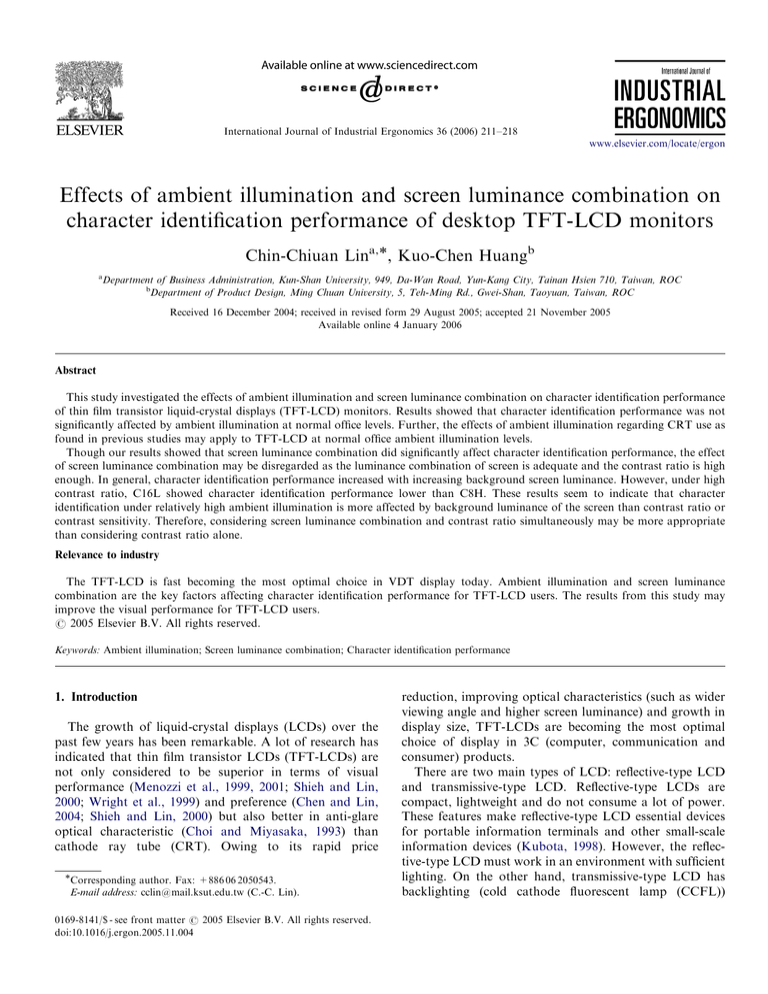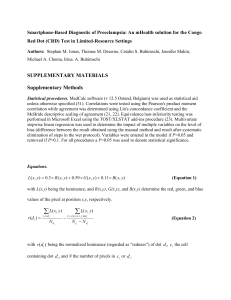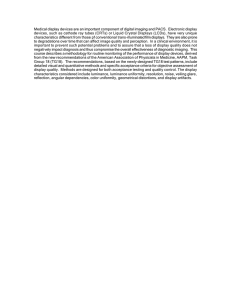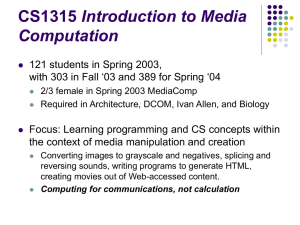
ARTICLE IN PRESS
International Journal of Industrial Ergonomics 36 (2006) 211–218
www.elsevier.com/locate/ergon
Effects of ambient illumination and screen luminance combination on
character identification performance of desktop TFT-LCD monitors
Chin-Chiuan Lina,, Kuo-Chen Huangb
a
Department of Business Administration, Kun-Shan University, 949, Da-Wan Road, Yun-Kang City, Tainan Hsien 710, Taiwan, ROC
b
Department of Product Design, Ming Chuan University, 5, Teh-Ming Rd., Gwei-Shan, Taoyuan, Taiwan, ROC
Received 16 December 2004; received in revised form 29 August 2005; accepted 21 November 2005
Available online 4 January 2006
Abstract
This study investigated the effects of ambient illumination and screen luminance combination on character identification performance
of thin film transistor liquid-crystal displays (TFT-LCD) monitors. Results showed that character identification performance was not
significantly affected by ambient illumination at normal office levels. Further, the effects of ambient illumination regarding CRT use as
found in previous studies may apply to TFT-LCD at normal office ambient illumination levels.
Though our results showed that screen luminance combination did significantly affect character identification performance, the effect
of screen luminance combination may be disregarded as the luminance combination of screen is adequate and the contrast ratio is high
enough. In general, character identification performance increased with increasing background screen luminance. However, under high
contrast ratio, C16L showed character identification performance lower than C8H. These results seem to indicate that character
identification under relatively high ambient illumination is more affected by background luminance of the screen than contrast ratio or
contrast sensitivity. Therefore, considering screen luminance combination and contrast ratio simultaneously may be more appropriate
than considering contrast ratio alone.
Relevance to industry
The TFT-LCD is fast becoming the most optimal choice in VDT display today. Ambient illumination and screen luminance
combination are the key factors affecting character identification performance for TFT-LCD users. The results from this study may
improve the visual performance for TFT-LCD users.
r 2005 Elsevier B.V. All rights reserved.
Keywords: Ambient illumination; Screen luminance combination; Character identification performance
1. Introduction
The growth of liquid-crystal displays (LCDs) over the
past few years has been remarkable. A lot of research has
indicated that thin film transistor LCDs (TFT-LCDs) are
not only considered to be superior in terms of visual
performance (Menozzi et al., 1999, 2001; Shieh and Lin,
2000; Wright et al., 1999) and preference (Chen and Lin,
2004; Shieh and Lin, 2000) but also better in anti-glare
optical characteristic (Choi and Miyasaka, 1993) than
cathode ray tube (CRT). Owing to its rapid price
Corresponding author. Fax: +886 06 2050543.
E-mail address: cclin@mail.ksut.edu.tw (C.-C. Lin).
0169-8141/$ - see front matter r 2005 Elsevier B.V. All rights reserved.
doi:10.1016/j.ergon.2005.11.004
reduction, improving optical characteristics (such as wider
viewing angle and higher screen luminance) and growth in
display size, TFT-LCDs are becoming the most optimal
choice of display in 3C (computer, communication and
consumer) products.
There are two main types of LCD: reflective-type LCD
and transmissive-type LCD. Reflective-type LCDs are
compact, lightweight and do not consume a lot of power.
These features make reflective-type LCD essential devices
for portable information terminals and other small-scale
information devices (Kubota, 1998). However, the reflective-type LCD must work in an environment with sufficient
lighting. On the other hand, transmissive-type LCD has
backlighting (cold cathode fluorescent lamp (CCFL))
ARTICLE IN PRESS
212
C.-C. Lin, K.-C. Huang / International Journal of Industrial Ergonomics 36 (2006) 211–218
system. Therefore, it can work under any environment with
varying lighting conditions (even in dark room).
When the display is placed in a light environment, surface
reflections are produced. Therefore, ambient illumination is
an important consideration in visual display terminal (VDT)
workplace design. For CRT workstations, ambient lighting of
150–500 lx is generally suggested (Helander and Rupp, 1984).
Unlike the highly reflective surface of the CRT screen, and
although the surface of TFT-LCD screen has an anti-glare
polarizer (Choi and Miyasaka, 1993), it still reflects the
ambient lighting (Kubo et al., 2000). Owing to the screen
reflecting a certain proportion of the ambient light towards
the user; the screen is lightened (Pawlak, 1986). Krantz et al.
(1992) indicated that the reflected light (RL) of TFT-LCD
was relative to incidental ambient illumination. Higher
incidental ambient illumination produced higher luminance
of RL. Therefore, the contrast ratio for a given TFT-LCD
and the actual luminance of the screen towards the user were
affected by the ambient illumination (Hori and Kondo, 1993;
Chung and Lu, 2003). Pawlak (1986) proposed that the
reflection property of a screen could be expressed as a
reflection factor (q). The reflected illumination (RE) is equal
to the reflection factor, multiplying the ambient illumination
(E) (RE ¼ qE). The luminance (cd/m2) of RL is equal to the
RE divided by 3.1417 (RL ¼ RE/3.1417) (Eperjesi et al.,
1995). Therefore, the luminance (cd/m2) of RL is equal to the
reflection factor, obtained through multiplying the illumination by the reflected ambient illumination (RL ¼ qE/3.1417).
When the level of ambient illumination increases, the RL
increases proportionally (Chung and Lu, 2003). The screen
luminance combination (SLC) is defined as the ratio of the
luminance of the lighter state (LMAX) to the luminance of the
darker state (LMIN). The SLCD (LMAX/LMIN) expressed the
screen luminance combination of the screen under dark room
conditions (E ¼ 0). Then the screen luminance combination
of the screen under ambient illumination conditions can be
expressed as SLCE ¼ (LMAX+RL)/(LMIN+RL). Pawlak
(1986) indicated that these same additive expressions for the
denominator and numerator cause a decrease in the screen
luminance combination (SLCEoSLCD).
Ambient illumination not only affected screen luminance,
Yoshida and Yamamoto (2003) also indicated that the
surface RL also affected the fluctuations in the chromaticity
coordinates of the primary colors. However, studies concerning ambient illumination on character identification performance for TFT-LCD are rare. Helander and Rupp (1984)
mentioned previously that the specifications for an ambient
illumination standard would become even more confusing in
the future as LCDs and other flat panel displays (FPDs)
become more popular. There is a need to evaluate the effects
of ambient illumination on character identification performance using TFT-LCD.
Color combination is one of the important factors for
VDT display design. The effect of color combination
on VDT display can be broken down into three subfactors: contrast ratio, chromaticity contrast, and polarity
(Fukuzumi et al., 1998).
Contrast ratio is the most important sub-factor of color
combination that affects significantly visual performance.
Generally, a higher contrast ratio resulted in better visual
performance with TFT-LCD (Chen and Lin, 2004; Lin,
2003). Further, the screen luminance of background and
stimulus were the two main components of contrast ratio.
Different luminance background and stimulus combinations can result in equivalent contrast ratios. For example,
a high luminance combination (200 cd/m2/100 cd/m2) and
low luminance combination (50 cd/m2/25 cd/m2) of background and stimulus resulted in an equivalent contrast
ratio of C2. Zhu and Wu (1990) indicated that raising
screen luminance may improve visual performance on low
contrast ratio, but higher screen luminance may have
adverse impact on visual performance on high contrast
ratio. They also proposed the optimal contrast range with
low screen luminance on CRT. However, the screen
luminances were relatively lower (20, 30, and 40 cd/m2) in
their study. Therefore, what screen luminance and combinations were better for visual performance on TFT-LCD
screen remain to be studied.
Chromaticity contrast is a sub-factor of color combination and can be an effective means for improving
human–computer communication (Pastoor, 1990; Shieh
et al., 1997). However, research has reported that
chromaticity contrast cannot effectively improve visual
performance if an acceptable level of contrast ratio was
present both in CRT (Spenkelink and Besuijen, 1996) and
in TFT-LCD (Chen and Lin, 2004; Shieh and Lin, 2000).
Moreover, though polarity was also a sub-factor of color
combination that may affect visual performance, positive
polarity (darker stimulus on lighter background) was the
most popular polarity used in a lot of software, and the
majority of researches indicated that positive polarity had
better visual performance than negative polarity (Pawlak,
1986; Saito et al., 1993; Taptagaporn and Saito, 1990).
In summary, the use of TFT-LCD is becoming more
popular, but studies concerning the effects of ambient
illumination and screen luminance combination on character identification performance with TFT-LCD are rare.
Because the optical characteristics of CRT and TFT-LCD
are different (MacKenzie and Riddersma, 1994; Post and
Reinhart, 1997; Stix, 1989), the effects of ambient
illumination and screen luminance combination on character identification performance regarding CRT use as
found in many studies may not apply to TFT-LCD. There
is a need, therefore, to evaluate empirically the effects of
ambient illumination and screen luminance combination
on character identification performance using TFT-LCD.
2. Method
2.1. Experimental design
The present study evaluated two independent variables:
ambient illumination and screen luminance combination.
ID
1097057
Title
Effectsofambientilluminationandscreenluminancecombinationoncharacteridentificationperformance
ofdesktopTFT-LCDmonitors
http://fulltext.study/article/1097057
http://FullText.Study
Pages
8



